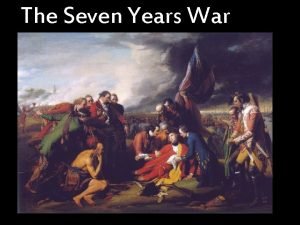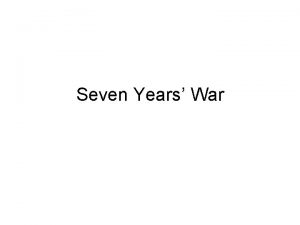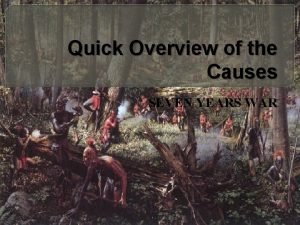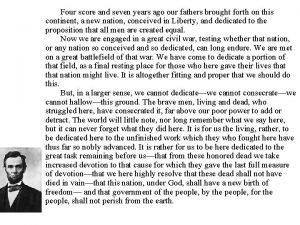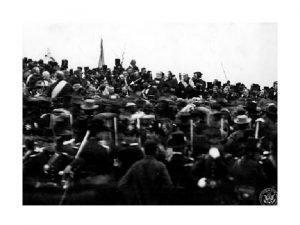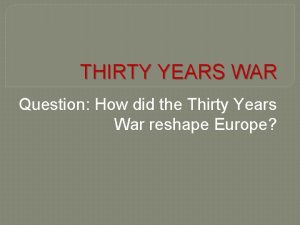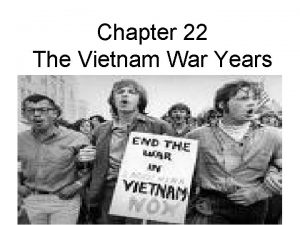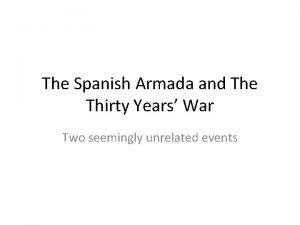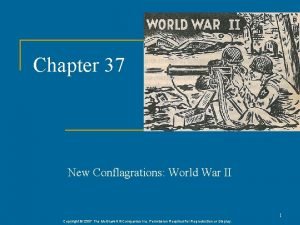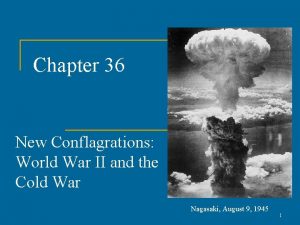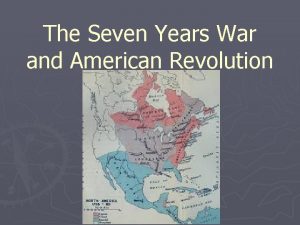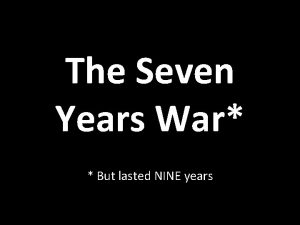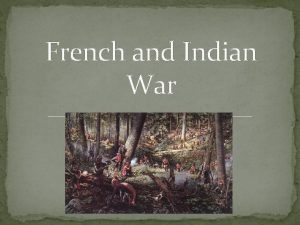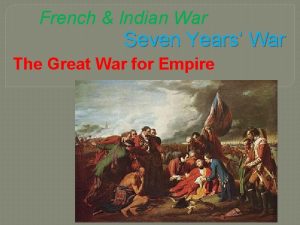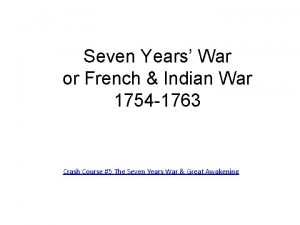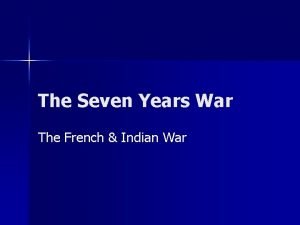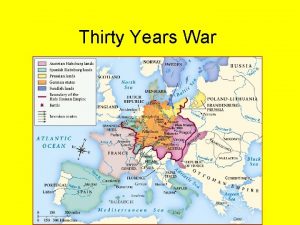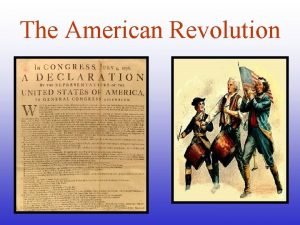The Seven Years War The Fall of New














































- Slides: 46

The Seven Years War The Fall of New France By: Kosta, Morgen, Lois & Stephanie

Seven Years War The seven year was a dispute between the British and the French. It began in 1754 in great Brittan and in 1756 the conflict moved to the west in Canada/US. The fight soon became over newly discovered territory in the west. The war was deemed the first global war.

French Indian War The first battle of the war took place in the Ohio valley passage In 1754 The British were lead 2, 000 in all by Major-General Edward Braddock through the valley in an attempt to take a very important French post for trade and tactics. The initial fight resulted in French victory and heavy British loss.

French Indian War continued Eventually the British took it and they built a small fort named Fort Prince George. Only months later the French came back with great force and the small British group quickly surrendered the fort. The fort was destroyed and in it’s place the French built Fort Duquesne named after Marquis Duquesne governor of Acadia.

French Indian War continued Although a strategic position it is hard to defend because it was surrounded by highland rivers The French defended it well but after the third attack lead by John Forbes it fell The British built a bigger fort and named it fort Pitt giving them a major foot hold.

Final Showdown after taking turns raiding forts the two armies met in full combat. in the Battle of Lake George there was no clear winner after heavy losses on each side they retreated. The French retreated to Ticonderoga point and built Fort Carillon (later captured and named Fort Ticonderoga) After this things slowed down in this area.

During the French and Indian war, the british wanted to make safe of any threats to them. The British interrupted the Acadians supply lines provided by Louisbourg.

French refused to sign an oath of allegiance to Britain. The French had there reasons for not signing this oath. They thought it would interfere with there Roman Catholic Faith

In 17 Th century most French lived in Acadia They got along with the Aboriginal people living there, learning their hunting and Fishing techniques. The British kicked about 14, 000 French people from there home land. Many French people were brought to New England.

After the expulsion, most French people wanted to reunite with their family. Some just went to different places and started over. Some moved to a less fertile Moncton area of new Brunswick.

George III was king/ over Britain during the seven year war. George was often accused of keeping great Britain at war. George appointed William pitt prime minister after the troubles in powers.

William pitt set attack to the prime minister. The prime minister served him country for 20 years. William change his ways to get King George attention. He wanted the King to give him a place in government.

Years later William got appoint as vice treasurer of Ireland. Later he got promoted to paymaster. Here he could show his public spirits and integrity which impressed the king and country.

The Fall of Louisbourg • France had been doing well in the war until 1757 but the after that it started going downhill. • Louisbourg was one of the strongest forts in North America.

The Fall of Louisbourg • The British army was led by General James Wolfe, a guy with a brilliant mind. • Wolfe was born in Westerham, England on January 2 nd 1727.

The Fall of Louisbourg Wolfe had always dreamed of joining the army as a young boy and could not for his first opportunity. At the age of 13 Wolfe joined his father’s regimen.

The Fall of Louisbourg • Even before the fighting started Wolfe became seriously ill and was brought home to his mother. • From now on throughout his whole life Wolfe would suffer from Chronic Gastrointestinal Illness, a bowel disease. • He recovered and at 14 he was appointed second lieutenant.

The Fall of Louisbourg • In 1744 Wolfe’s beloved brother Edward died from consumption, James had idolized him. • James Wolfe flourished in the army and he became an experienced military officer before he came to Canada.

The Fall of Louisbourg Wolfe’s enthusiasm, constant industry, and inspiration to the men is what gave the British success. He was sent, along with Amherst, to attack Louisbourg.

The Fall of Louisbourg • The French population in Acadia might not have been so bothersome to the British if they would have been isolated from other Frenchman. • The Acadians had pledged to be neutral, but they continued to visit their French neighbours at Louisbourg.

The Fall of Louisbourg • Amherst had 13, 200 men, doubling the men in Louisbourg, 7, 000. • Command of the fleet was given to Admiral Boscawen, who knew the American waters well.

The Fall of Louisbourg • The entire attack was delayed by bad weather and problems crossing the Atlantic; they did not arrive until June 2 nd. • The French had managed to get enough ships to prevent a naval assault on the harbour.

The Fall of Louisbourg • The British got pretty lucky. The French had fortified the obvious landing places and the British attempt on June 8 almost failed, had not two junior officers spotted a small, rocky creek that wasn’t fortified.

The Fall of Louisbourg • By the time the French realized what had happened several thousands of British troops had already reached land, and the French were forced to fall back on the fort. • It took the British till the end of July to establish their line of guns.

The Fall of Louisbourg • The last hope for the French was their ships of the line, that with their guns were able to threaten the siege. • On July 21 a lucky shot from the British hit the powder store in one of the ships and set two more on fire.

The Fall of Louisbourg • The burning ships inflicted great damage on the town when fire spread, threatening both town and ships. • The town finally surrendered on July 27 th, giving the British their first victory during the war.

The Fall of Louisbourg The fighting wasn’t heavy and the loss on both sides together was only fiver per cent. The taking of Louisbourg was very important to clear the way to Quebec.

The Fall of Louisbourg The stage is now set for a final attack on the heart of New France, the original settlements of Montreal and Quebec. James Wolfe was chosen for his previous victory at Louisbourg to attack Quebec. His opponent would be the most succesful French general in this war, the marquis de Montcalm.

The Battle of the Plains of Abraham For France, the war in Europe was the top priority, so the country only sent a few troops. It was more important to protect its colonies in the West Indies, since sugar cane was more beneficial than the fur trade in New France.

The Battle of the Plains of Abraham Continued For New England, it was essential to destroy New France and its Native allies. They wanted the land to occupy and farm. The French army was divided. 3, 000 of their best men were to the west.

The Battle of the Plains of Abraham Continued Even though Montcalm had 10, 000 men, over 7, 000 of them were mercenaries. Foolishly, Montcalm did not wait for his 3, 000 men to come.

The Battle of the Plains of Abraham Continued The British were ahead and well organized while the French came in great disorder. James Wolfe had successfully crossed the St. Lawrence river above Quebec.

The Battle of the Plains of Abraham Continued Wolfe was forming an army in Halifax. A three month siege and an bombardment of the city followed. Wolfe took 9, 000 troops and 200 ships to a dangerous landing at the base of the cliffs on St. Lawrence River.

The Battle of the Plains of Abraham Continued The French defenders felt protected by the high cliffs that appeared to block any attack. Wolfe scouted a route up the cliffs and found weak French guards that had fallen asleep. By dawn 4, 828 British men on the top of the cliffs west of the city. He struck his attack at 10 in the morning.

The Battle of the Plains of Abraham Continued When the British tents were seen, Montcalm went to scout it out. Even after seeing the British force he refused to believe that it was anything more than a small raiding force. Wolfe marched his force within a mile of the city, and formed up ready for battle.

The Battle of the Plains of Abraham Continued Montcalm’s command was to hold New France as long as possible. Realizing that Wolfe would bring up cannons Montcalm’s troops formed up on the Plains of Abraham.

The Battle of the Plains of Abraham Continued The French attacked wildly but it didn’t do much good. The first attack of the British was hard and forced the French to fall back. Wolfe then ordered a spear charge, which he led himself. Wolfe got a bullet in the chest which eventually killed him. The charge was a success.

The Battle of the Plains of Abraham Continued Wolfe and Montcalm were fatally injured. Montcalm died of his wounds the next day. Wolfe survived long enough to know he had won Quebec surrendered on 18 th of September.

The Battle of the Plains of Abraham Ended Some time later Chevalier de Lévis replaced Montcalm. The French were unable to resupply their forces. This forced Lévisto to surrender in September, ceding Canada to Britain.

Treaty of Paris The Treat of Paris happened in 1763. This was the treaty of peace. It was signed on February 10, 1763. It brought an end to the Seven Years War between Great Britain and France. By which France ceded Canada to Great Britain.

Treaty of Paris Also Canada, with all its dependencies, and the Island of Cape Breton, and all the other islands and coasts in the gulf and river of St. Lawrence was given to Great Britain. In return, the King of Great Britain gave the freedom of the Catholic Religion to the people of Canada.

Treaty of Paris Also, that the French people living Canada might leave from without difficulty. French fishermen were also allowed to fish in the gulf of St. Lawrence. The freedom of fishing and drying on parts of the coasts of Newfoundland was also given.

Treaty of Paris Also, the ownership of the islands of St. Pierre and Miquelon was given. Louisiana remained a French possession. The French posts on the upper Mississippi were ceded to Great Britain, with all the territories occupied by the French fur-traders in the Old North West.

Treaty of Paris The West Indies, the subcontinent of India, Europe and America. In a proposal to save the colonies which brought in the most money, France ceded New France in a Treaty signed in 1763 in exchange for keeping the West Indies. This move angered the Native allies, who were the Canadians' allies. Some of them regrouped under the leadership of Pontiac and tried to

Video Clip. . .

BY: KOSTA, LOIS, MORGEN, & STEPH
 How long is four score years
How long is four score years What caused the seven years war
What caused the seven years war Causes of seven years war
Causes of seven years war What caused the seven years war
What caused the seven years war Seven years war
Seven years war Pontiac's rebellion apush
Pontiac's rebellion apush New years old is new again
New years old is new again Goat years to human years
Goat years to human years 300 solar years to lunar years
300 solar years to lunar years Four score and seven years ago
Four score and seven years ago Last seven years
Last seven years How many years are four score and seven
How many years are four score and seven 7 deadly sins ritual
7 deadly sins ritual Thirty years' war causes
Thirty years' war causes Prussia
Prussia 30 years war phases
30 years war phases The domino theory vietnam war
The domino theory vietnam war Hapsburgs
Hapsburgs 1453-1337
1453-1337 Consequences of the 100 years war
Consequences of the 100 years war New years sermon outline
New years sermon outline War at home and abroad madison
War at home and abroad madison Description
Description The cold war lesson 1 the cold war begins
The cold war lesson 1 the cold war begins Presidential and congressional reconstruction venn diagram
Presidential and congressional reconstruction venn diagram Why did josette dugas want to go to war
Why did josette dugas want to go to war Sein war
Sein war Balanced force
Balanced force Why was the civil war considered the first modern war
Why was the civil war considered the first modern war Already simple past
Already simple past Toward civil war lesson 3 secession and war
Toward civil war lesson 3 secession and war Proxy wars cold war
Proxy wars cold war Chapter 30 the war to end war
Chapter 30 the war to end war Chapter 30 the war to end war
Chapter 30 the war to end war New seven wonders foundation
New seven wonders foundation Language windows 10
Language windows 10 Chapter 37 new conflagrations world war ii
Chapter 37 new conflagrations world war ii New conflagrations world war ii
New conflagrations world war ii Hình ảnh bộ gõ cơ thể búng tay
Hình ảnh bộ gõ cơ thể búng tay Slidetodoc
Slidetodoc Bổ thể
Bổ thể Tỉ lệ cơ thể trẻ em
Tỉ lệ cơ thể trẻ em Chó sói
Chó sói Chụp tư thế worms-breton
Chụp tư thế worms-breton Alleluia hat len nguoi oi
Alleluia hat len nguoi oi Các môn thể thao bắt đầu bằng tiếng chạy
Các môn thể thao bắt đầu bằng tiếng chạy Thế nào là hệ số cao nhất
Thế nào là hệ số cao nhất

